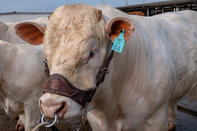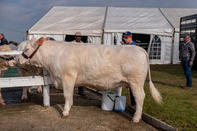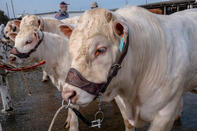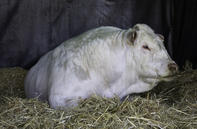The Charolais, one of the oldest of several French cattle breeds, is thought to have originated in the Jura mountains of Eastern France.

From there, the breed made its way to the old province of Charroles. Its namesake, from where it became well known for its excellent meat quality at the markets of Lyon and Villefranche around the 16th and 17th century.
Production was confined to Charroles until 1773, when Claude Matheiu, a popular breeder from the region, moved with his herd to Nievre. The cattle did so well in Nievre that there was a time that they were better known as Nivernais cattle than by their original name, Charolais. The breed grew in popularity and by 1907 there were over a million Charolais cattle registered across France.
The breed was initially also used as a draught animal, because of their strong masculinity and constitution. A bigger focus was placed on functional meat qualities as of the 1920s. The main aim from then on was to produce fast-growing, fertile cattle with excellent meat, without this having a negative impact on the resilience, temperament and the breed’s adaptability to different climatic conditions.
Production in South Africa
South Africa imported its first Charolais cattle - three cows and one bull, in 1955. Thereafter, the breed grew slowly with small numbers of cattle being imported from time to time, until the year 1964 when 1605 cows and 259 bulls were imported. From then on, there was a shift towards semen imports.
The South African Charolais Cattle Breeders Society was established on 25 March 1966.
Attributes

Charolais has gone through a metamorphosis in South Africa, without this having a negative impact on the breeds’ popular traits. Prepotency, the breed’s ability to transmit its character to its offspring, is particularly strong for the Charolais because it has been purebred for more than 370 years. On colour alone, it is known that the second generation animal will already be white.
One of the biggest mistakes made with the Charolais in South Africa, as reflected by the Charolais Cattle Breeders Society, was that too much emphasis was placed on the masculinity and size of the first imported animals. This resulted in calving problems and in cows not having enough milk to raise their calves. As semen imports increased, other structural problems, such as poor legs, began to emerge.
These issues have been addressed since the 1990s, through the implementation of strict import restrictions to ensure that imported semen comply with breed requirements and standards, such as smaller frames and ease of calving. Performance testing became compulsory in 1997, which made it easier to cull poor quality animals. In addition, a strict linear classification system has been used since 2000 to ensure only the best animals become part of the breed.
A strong emphasis has been placed on the development of good fertility and mothering properties, resulting in the inter calf period of the breed decreasing from 424 to 417 days. Poor milk production has also been addressed, which has resulted in Charolais cows weaning some of the heaviest calves of all the breeds.
Production Region

The breed has been sold from South Africa to various Southern African countries such as Namibia, Botswana and Zimbabwe because of its high adaptability and excellent meat properties. The Charolais is also produced in Zambia and other African countries.
In South Africa, it is produced across all nine provinces but is particularly popular in the warmer parts of the North West and the Northern Cape.
Use
Besides stud breeding, numerous commercial producers are farming extensively with Charolais. The bulls are often used for cross breeding with smaller framed cattle, resulting in offspring that are in higher demand with feeding lots.
Genomic testing has revealed that the cattle are a small concentrated group, completely different from any other breed, which results in excellent hybrid vigour (heterosis) during cross-breeding.
Meat Quality

The breed is in high demand at feedlots, as a pure breed and cross, due to its excellent growth and feed conversion rate. The breed also only puts on fat at the late stage of production, which not only reduces production costs but renders it economically viable for feedlots to keep and feed the animals for longer when meat prices are unfavourable.
The large carcasses of the animals make it easier to debone and reduces processing and transport costs.
For bulk or Charolais Beef export enquiries please use the enquiry link below.